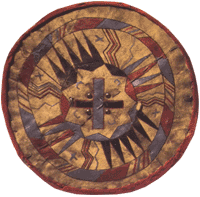





The Confederated Salish and Kootenai Tribes of the Flathead Reservation are the Bitterroot Salish, Kootenai and Pend d'Oreilles Tribes. They lived between the Cascade Mountains and Rocky Mountains and were called the Flathead Indians by the first white men who came to the Columbia River. The name is often said to derive from the flat skull produced by binding infant's skulls with boards. However, this is a misnomer because the tribes never practiced head flattening. In fact, the tribes which did called the Salish "flat head" because the tops of their heads were flat and not pointed. The Flatheads call themselves "Salish" meaning the people.
The written record of the tribes is from their meeting with the Lewis and Clark expedition (September 5, 1805). They also appear in the records of the Catholic Church at St. Louis, to which they sent four delegations to request missionaries (or "Black Robes") to minister to the tribe. Their request was finally granted and a number of missionaries including Peter De Smet, S.J., were eventually sent. The tribes negotiated the Treaty of Hellgate with the United States in 1855. Under the terms of the treaty the tribes agreed to be resettled on the current Flathead Reservation pending a survey to see if the Bitterrot Valley was not a more suitable location (Article XI). As the survey was never conducted, a band of Salish under Chief Charlot refused to relocate, and held out in the Bitterroot Valley until 1891.
The tribe has about 6,800 members. 4,000 tribal members currently live on the Flathead Reservation and 2,800 tribal members live off the reservation. 1,100 Native Americans from other tribes and over 10,000 non-Native Americans also live on the reservation. As the first to organize a tribal government under the Indian Reorganization Act of 1936 they are governed by a tribal council. The tribal government offers a number of services to tribal members and is the chief employer on the reservation. The tribes operate a tribal college, the Salish-Kootenai College (SKC) and a heritage museum called "The People's Center" in Pablo, MT. The tribes own and jointly operate a valuable hydropower dam called Kerr Dam.
